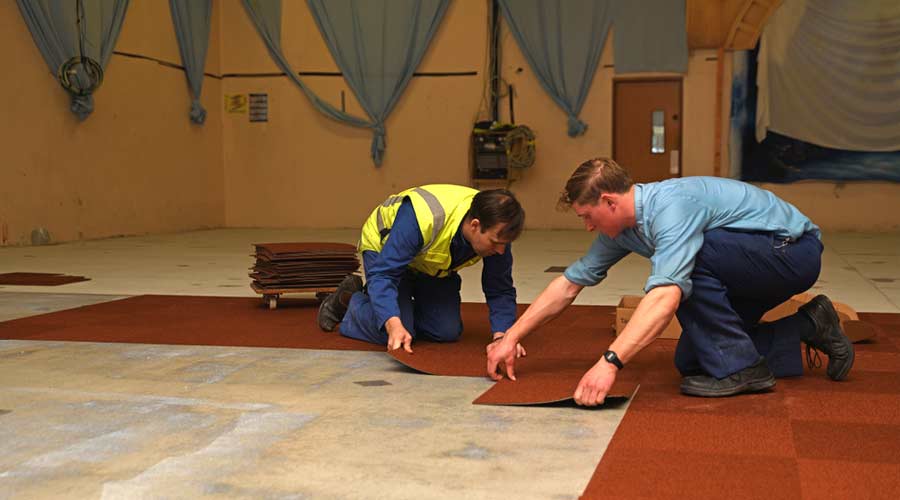
Initially developed for high-traffic areas, carpet tiles are gaining traction in businesses where roll carpets once dominated. These quick-change carpet squares — also known as modular carpets — are being used in a wide range of facilities, including airports, universities, office buildings and hotels.
Utilitarian by design, carpet tiles are easy to install and replace. And with today’s diverse patterns and textures, installed tiles appear seamless, creating a carpeted surface that is both functional and attractive.
“Carpet tiles are seen mostly in hallways and passageways, where they were originally intended for use, but they are starting to migrate into other areas of the facility,” notes Stan Hulin, CEO of Future Floor Technology Inc., Gladstone, Oregon. “And although carpets are losing ground to hard flooring every year, carpet tiles have brought carpeting back to the forefront.”
Recent research seems to support Hulin’s claim: According to a 2022–2023 report by consulting firm Mordor Intelligence, the global carpet tile market is anticipated to grow considerably, with an expected compound annual growth rate (CAGR) greater than 4.5 percent during the forecast period of 2021–2026.
A Vote for Squares
In facilities with broadloom carpeting, stains and wear patterns may require the entire carpet to be replaced, sometimes well before the end of its lifespan. Similar issues with carpet tiles can be addressed by replacing or switching out the offending tiles. According to industry consultants, this is one of modular carpeting’s greatest assets.
“The biggest benefit of carpet tiles is being able to replace worn-out, damaged, or stained areas without having to replace the whole carpet,” notes Hulin.
Indeed, modular tiles are not only easy to install, but easy to remove, making them an economical alternative to the labor-intensive process and high cost of traditional carpet installations.
“One of the advantages of carpet tiles is when you have to replace them, you might not have to move out as much of the furniture or partitions as you had to before,” says Dane Gregory, national sales manager for Carpet Cleaner America, Spartanburg, South Carolina. “You can pick up the tiles one at a time and reinstall them one at a time. When it comes to shipping and handling, boxes of tiles are also easier to move, and take up less room than rolls of carpet.”
Despite their many benefits, carpet tiles do have one potential drawback. When replacing worn or stained tiles, new tiles look different and tend to stick out like a sore thumb.
“I transfer through the Minneapolis airport all the time, and I can see where they’ve installed new carpet tiles from several gates away,” says Gregory. “They’re much brighter and cleaner than the surrounding traffic areas.”
Fortunately, new carpet tiles will blend in with the surrounding tiles as they submit to foot traffic over time. However, for a speedier solution, consultants advise rotating tiles. Considering that 20 percent of the carpet receives 80 percent of the foot traffic, facilities can pull up stained or worn tiles and swap them out with inconspicuous corner or edge tiles that may blend in better with the surrounding tiles.
Not only are carpet tiles easy to replace, but they are more resilient than their predecessors, allowing them to be installed — and reinstalled — over a variety of surfaces.
“The quality of the backing material has improved over the years,” says Bill Griffin, president, Cleaning Consultant Services Inc., Seattle. “They’re waterproof and more durable, so they’re not as susceptible to damage like many other types of carpet.”
While traditional carpets are sometimes damaged through over-saturation during the cleaning process, this is seldom a concern with modular carpets, according to industry experts.
“Carpet tiles will never warp or ripple like a stretched carpet because they have a heavy backing that sits flush to the floor, and there isn’t enough surface area for warping to occur,” notes Hulin. “Even if you flooded the tiles, the only thing you have to worry about is cleaning solution seeping between the seams and breaking down the adhesive on the back.”
Tiles Have Your Back
Luckily, carpet tiles are easy to maintain thanks to their sturdy construction and water-resistant backing.
“The quality of the backing materials has changed and improved over the years,” notes Griffin. “The tiles are easier to clean and more resistant to problems with moisture from cleaning or even abrasion from the cleaning process.”
But Ron Segura, president of Segura & Associates, notes that this wasn’t always the case. He stresses that carpet tiles have come a long way.
“Back in the early 1980s, it was a process to maintain carpet tiles once they were installed,” Segura recalls. “You had to pull them out one by one, wash them by hand in a bucket of water, and then put them back in.”
Today, carpet tiles can be cleaned successfully using the same procedures as regular carpet care programs. Because modular carpets typically have tighter weaves and shorter piles than broadloom carpets, soil releases easily, allowing them to be vacuumed more efficiently. Moreover, they tend to resist staining and wicking issues.
“If you have a spill on a broadloom carpet with an open weave back, the spill can go through the carpet into the substrate,” explains Gregory. “With carpet tiles, the spill will stay in the fibers and won’t be able to penetrate through the PVC backing.”
In traditional carpets, soils embedded in the backing will wick back to the surface of the fibers as the carpet dries after wet cleaning procedures. With carpet tiles, the chances of dirt wicking back to the surface are greatly reduced.
Carpet Tile Maintenance Tips

 The Down and Dirty on Cleaning in Virus Season
The Down and Dirty on Cleaning in Virus Season How Surfactant Use is Expanding in Commercial Cleaning
How Surfactant Use is Expanding in Commercial Cleaning Maximize Your Margins: Learn How to Automate Pricing and Track Rebates
Maximize Your Margins: Learn How to Automate Pricing and Track Rebates